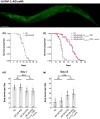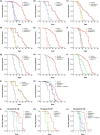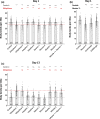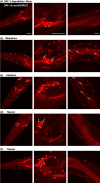DAF-2/insulin IGF-1 receptor regulates motility during aging by integrating opposite signaling from muscle and neuronal tissues
- PMID: 35808897
- PMCID: PMC9381905
- DOI: 10.1111/acel.13660
DAF-2/insulin IGF-1 receptor regulates motility during aging by integrating opposite signaling from muscle and neuronal tissues
Abstract
During aging, preservation of locomotion is generally considered an indicator of sustained good health, in elderlies and in animal models. In Caenorhabditis elegans, mutants of the insulin-IGF-1 receptor DAF2/IIRc represent a paradigm of healthy aging, as their increased lifespan is accompanied by a delay in age-related loss of motility. Here, we investigated the DAF-2/IIRc-dependent relationship between longevity and motility using an auxin-inducible degron to trigger tissue-specific degradation of endogenous DAF-2/IIRc. As previously reported, inactivation of DAF-2/IIRc in neurons or intestine was sufficient to extend the lifespan of worms, whereas depletion in epidermis, germline, or muscle was not. However, neither intestinal nor neuronal depletion of DAF-2/IIRc prevented the age-related loss of motility. In 1-day-old adults, DAF-2/IIRc depletion in neurons reduced motility in a DAF-16/FOXO dependent manner, while muscle depletion had no effect. By contrast, DAF-2 depletion in the muscle of middle-age animals improved their motility independently of DAF-16/FOXO but required UNC-120/SRF. Yet, neuronal or muscle DAF-2/IIRc depletion both preserved the mitochondria network in aging muscle. Overall, these results show that the motility pattern of daf-2 mutants is determined by the sequential and opposing impact of neurons and muscle tissues and can be dissociated from the regulation of the lifespan. This work also provides the characterization of a versatile tool to analyze the tissue-specific contribution of insulin-like signaling in integrated phenotypes at the whole organism level.
Keywords: daf-2; DAF-16/FOXO; UNC-120/SRF; insulin/IGF-1 signaling; lifespan; mitochondria; motility; oxidative stress.
© 2022 The Authors. Aging Cell published by Anatomical Society and John Wiley & Sons Ltd.
Conflict of interest statement
The authors declare no conflict of interest.
Figures






Similar articles
-
End-of-life targeted degradation of DAF-2 insulin/IGF-1 receptor promotes longevity free from growth-related pathologies.Elife. 2021 Sep 10;10:e71335. doi: 10.7554/eLife.71335. Elife. 2021. PMID: 34505574 Free PMC article.
-
A PTEN variant uncouples longevity from impaired fitness in Caenorhabditis elegans with reduced insulin/IGF-1 signaling.Nat Commun. 2021 Sep 24;12(1):5631. doi: 10.1038/s41467-021-25920-w. Nat Commun. 2021. PMID: 34561453 Free PMC article.
-
Intestine-specific removal of DAF-2 nearly doubles lifespan in Caenorhabditis elegans with little fitness cost.Nat Commun. 2022 Oct 25;13(1):6339. doi: 10.1038/s41467-022-33850-4. Nat Commun. 2022. PMID: 36284093 Free PMC article.
-
The search for DAF-16/FOXO transcriptional targets: approaches and discoveries.Exp Gerontol. 2006 Oct;41(10):910-21. doi: 10.1016/j.exger.2006.06.040. Epub 2006 Aug 24. Exp Gerontol. 2006. PMID: 16934425 Review.
-
Worming pathways to and from DAF-16/FOXO.Exp Gerontol. 2006 Oct;41(10):928-34. doi: 10.1016/j.exger.2006.05.020. Epub 2006 Jul 12. Exp Gerontol. 2006. PMID: 16839734 Review.
Cited by
-
A comprehensive approach, based on the use of Caenorhabditis elegans, mouse, and human models, elucidates the impact of Lactiplantibacillus plantarum TWK10 on exercise performance and longevity.Curr Res Food Sci. 2025 Mar 6;10:101015. doi: 10.1016/j.crfs.2025.101015. eCollection 2025. Curr Res Food Sci. 2025. PMID: 40144895 Free PMC article.
-
Too old for healthy aging? Exploring age limits of longevity treatments.NPJ Metab Health Dis. 2024;2(1):37. doi: 10.1038/s44324-024-00040-3. Epub 2024 Dec 12. NPJ Metab Health Dis. 2024. PMID: 39678297 Free PMC article. Review.
-
Combinatorial transcriptomic and genetic dissection of insulin/IGF-1 signaling-regulated longevity in Caenorhabditis elegans.Aging Cell. 2024 Jul;23(7):e14151. doi: 10.1111/acel.14151. Epub 2024 Mar 26. Aging Cell. 2024. PMID: 38529797 Free PMC article.
-
Considering Caenorhabditis elegans Aging on a Temporal and Tissue Scale: The Case of Insulin/IGF-1 Signaling.Cells. 2024 Feb 5;13(3):288. doi: 10.3390/cells13030288. Cells. 2024. PMID: 38334680 Free PMC article. Review.
-
Loss of neuropeptidergic regulation of cholinergic transmission induces homeostatic compensation in muscle cells to preserve synaptic strength.PLoS Biol. 2025 May 8;23(5):e3003171. doi: 10.1371/journal.pbio.3003171. eCollection 2025 May. PLoS Biol. 2025. PMID: 40338987 Free PMC article.
References
-
- Boothe, T. , Lim, G. E. , Cen, H. , Skovsø, S. , Piske, M. , Li, S. N. , Nabi, I. R. , Gilon, P. , & Johnson, J. D. (2016). Inter‐domain tagging implicates caveolin‐1 in insulin receptor trafficking and Erk signaling bias in pancreatic beta‐cells. Molecular Metabolism, 5, 366–378. 10.1016/j.molmet.2016.01.009 - DOI - PMC - PubMed
Publication types
MeSH terms
Substances
Grants and funding
LinkOut - more resources
Full Text Sources
Research Materials
Miscellaneous

